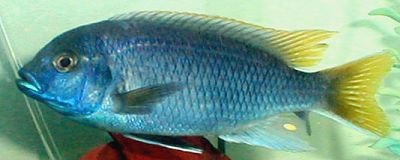

Above: Pseudotropheus sp. "acei," a large captive male photographed by James Stewart; photo used with his generous permission. Up to now, this extremely popular and widely available Mbuna species is scientifically undescribed, so far as I know, and therefore does not have a scientific name.
Superficially, Pseudotropheus sp. "acei" strongly resembles species of the genus Gephyrochromis, G. moorii and G. lawsi, and may be closely related to them. However, "acei" has standard Pseudotropheus outer jaw teeth (stout and bicuspid), whereas Gephyrochromis species have long, slender teeth with a variable number of cusps.

A female Ps. 'acei'; note the solid yellow dorsal fin. Photo by Gelo Xuts, used by permission. |
According to Konings (1995c), Ps. sp. "acei" eats algae, like many other Mbuna, but algae from a highly unusual source. It eats the algae (Aufwuchs) that grow on waterlogged wood — logs and tree branches washed into the lake. No other cichlid species is known to exploit this specific food source, which I would suggest could be called epixylic algae (algae growing upon wood). It appears to me to be only behaviorally specialized for this diet, in that it forms aggregations near, and feeds from the surfaces of, the submerged logs and branches. Anatomical specializations for this specific diet, if any, are not evident; the jaws and dentition closely resemble those of many Mbuna that feed on the algae growing on rocks (epilithic algae).
Pseudotropheus sp. "acei" is reportedly restricted to sandy shores on the west coast of Lake Malawi (Konings inadvertently wrote "east coast," but all the localities he cites — Nkhata Bay, Bandawe, Ngara, Karonga, Ruarwe, the South Rukuru River, and Senga Bay — are on the lake's western shore).

A male Ps. 'acei'; the spinous part of the dorsal fin is pale blue and iridescent. Photo by Gelo Xuts, used by permission. |
Konings (1995c: 246) recognized four geographical variants or populations of "acei," as follows:
Both males and females of the population between Nkhata Bay and Bandawe are blue with yellow fins. This is the variant that was first exported some years ago. The population between Ngara and Karonga is similar except that the fins are white. The trade name for this population is »White-Tail Acei«. A third population occurs between the South Rukuru River and Ruarwe, and in colour pattern closely resembles the fourth population ... found in Senga Bay, and that of G. moorii....
As for reproduction in the wild and in captivity, Konings (op. cit.: 246) stated:
In captivity the »Acei« breeds throughout the year. In the aquarium males excavate nests between rocks and are territorial. In the lake males in breeding coloration [which Konings does not describe] are not territorial and do not seem to build a nest. Interestingly, at Ngarathousands (!) of individuals of the »White-Tail Acei« have been seen to form massive schools near a single tree trunk. [Konings provides a color photograph of this aggregation.]

Another view of the male Ps. 'acei.' Photo by Gelo Xuts, used by permission.
In the aquarium, the graceful, rather elongate shape and beautiful pastel coloration of Pseudotropheus sp. "acei" make it a current favorite, widely available at least in the USA. It attains a length in excess of 4 inches (10 cm), and is not a bad choice for the novice at keeping Malawi cichlids, provided that a large enough aquarium can be used; say, 40 gallons (150 liters) minimum and preferably larger. As already noted above, this species is territorial, at least in captivity, and can be quite aggressive. A single male and three or four females makes a desirable group.
Remember that its diet is principally algae, and avoid feeding "meaty" foods such as
live or frozen Daphnia, bloodworms, or brine shrimp more than about once a week.
Dried seaweed (nori), flake foods rich in Sprirulina, and other green plant
foods should be the staple diet. As with all Malawi cichlids, avoid overfeeding and
withhold all foods at least one day a week. And, of course, change 30-40% of the water
faithfully every week.

| Last Update: 28 April 2019
Web Author: M. K. Oliver, Ph.D. Copyright © 1997-2021 by M. K. Oliver, Ph.D. - ALL RIGHTS RESERVED |